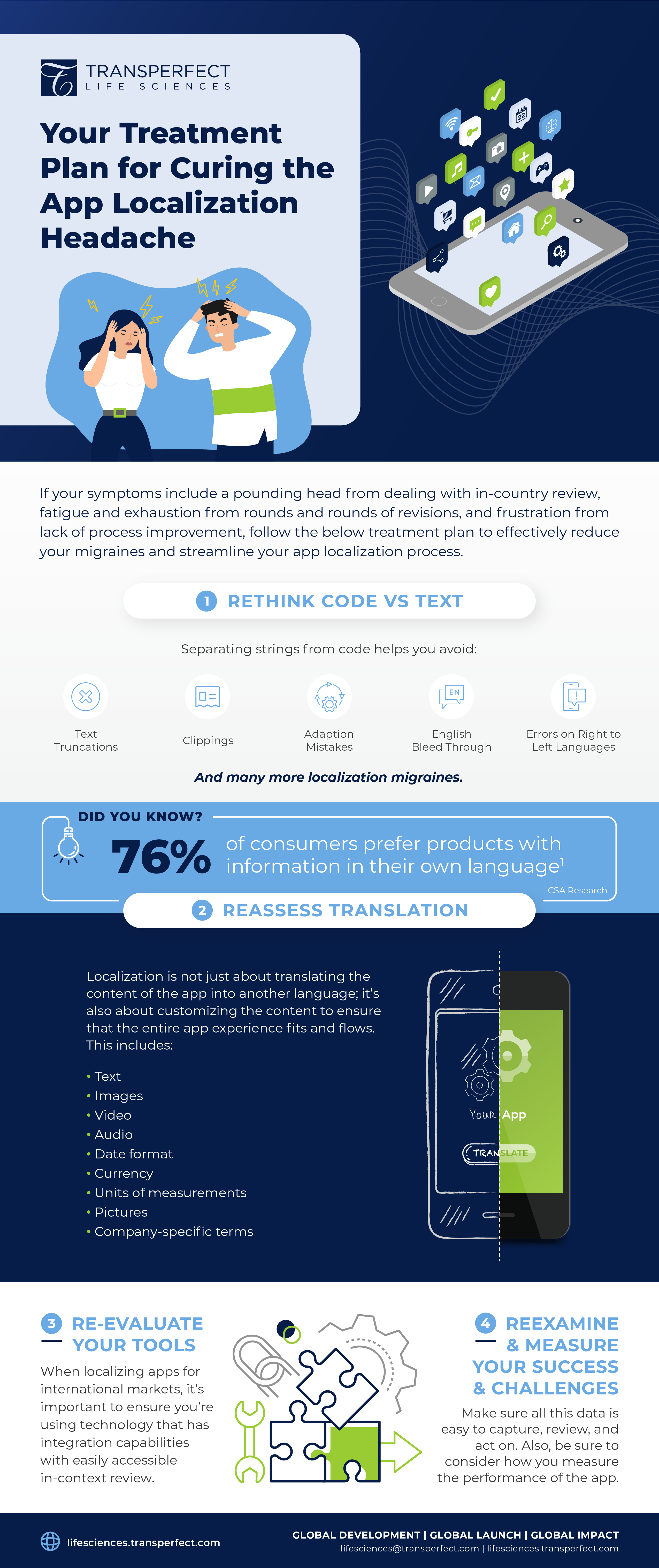Your Treatment Plan for Curing the App Localization Headache


If translation had a prefrontal cortex, in-country review would create quite the headache.
This is particularly true for app localization. App localization is the process of adapting apps and their content to another language in a conceptually equivalent and culturally appropriate way. Historically, both translators and in-country reviewers work within string files and code; the pain grows stronger and painkillers don’t seem to work.
In this article, we’ll tackle how you can treat the source of the pain and not just the symptoms. Spoiler alert: it is not removing the in-country review step!
What’s the Diagnosis, Doc?
A question we see a lot is, why should you keep in-country review in the translation workflow when it can cause these headaches? Simple: in-country review is extremely important for adding extraordinary value to the localization process.
Your in-country colleagues are your local in-market experts. They live your culture, are champions of your company philosophy, mission, and vision, and know your products and customers better than anyone else.
If done effectively, all their input can be captured in translation tools such as translation memory (TM), style guides, and glossaries. Eventually, the review is reduced to a minimal and streamlined effort.
Getting to the point where the review is streamlined doesn’t have to be complex. Here are some treatment options on how to heal the in-country review headache.
Recommended Treatment Options
Step 1: Rethink Code vs. Content
Often, when life sciences organizations are adapting their apps for other markets, they typically think about content first, then code. This can create text truncations, clippings, adaption mistakes, English bleed through, errors on right to left languages, and many more localization migraines.

Because of this, it’s important to separate the strings from the code. To streamline the localization process, an app must be ready for localization with the ability to be modified and released in multiple languages—a process known as internationalization (or i18n for short). This means it should be adaptable to multiple languages and cultural specifics. Further, i18n should always be done before translation and in-country review, and generally done in parallel with the overall development process. This way, you can ensure the app is ready for localized content.
Step 2: Reassess Translation
Localization is not just about translating the content of the app into another language; it’s also about customizing the content to ensure that the entire app experience fits and flows. This includes text, images, video, audio, date format, currency, units of measurements, pictures, company-specific terms, etc.
Many apps have specific legal, cookie, and GDPR policies to comply with. Life sciences apps have additional elements that must be considered, including informed consent forms, instructions for use for the app itself and for relevant devices, clinical outcome assessments (COAs) and questionnaires, and scales, just to name a few. Since all this content is very different, it requires different subject matter expertise; however, it must remain consistent with branding and conceptual equivalency to its original form.
Here are a few considerations:
1. Align your team on in-country specific preferences, glossaries, and style guides. Once aligned, work with your translation provider to ensure all elements are in the translation management systems (TMS) and TM database before you start translating.
2. Give context by using tools designed to make content that is easy to share, translate, review, and import back into the app. Most importantly, be sure to provide translators and in-country reviewers context for the content and workflow.
3. Consistency is key! Make sure your translation partner can support on all the different content types, including video, audio, graphics, legal policy, design work, and plain text.
Step 3: Reevaluate Your Tools
When localizing apps for international markets, it’s important to ensure you’re using technology that has integration capabilities with easily accessible in-context review. This enables you to source content from the app, translate and review, and push translated content back into the app in an efficient and streamlined manner. Leveraging the right technology for you and your business needs will support your in-country teams by reducing the burden and cutting down review rounds. An example of this would be utilizing a tool that features in-context review, where users can review screenshots of an app directly in the editor interface using any browser from anywhere in the world.
Step 4: Reexamine and Measure Your Success and Challenges
After the project, do a lessons learned and ask these questions:
• How long did it take you to share the final content with your translation provider?
• How long did the translation process take?
• How long did it take for your in-country reviewers to review?
• How much time did they spend on editing segments?
• How quickly were the edits implemented and sent to the developers?
Make sure all this data is easy to capture, review, and act on. Also, be sure to consider how you measure the performance of the app. This can be done through engaging a social listening campaign in the market that you launched into, conducting market research of your competitor’s tools, and using the data to improve your product. By following this treatment plan, you’ll be well on your way to curing the app localization headache.
Interested in learning more about TransPerfect’s app localization tool? Check out more information here or contact us at lifesciences@transperfect.com.




